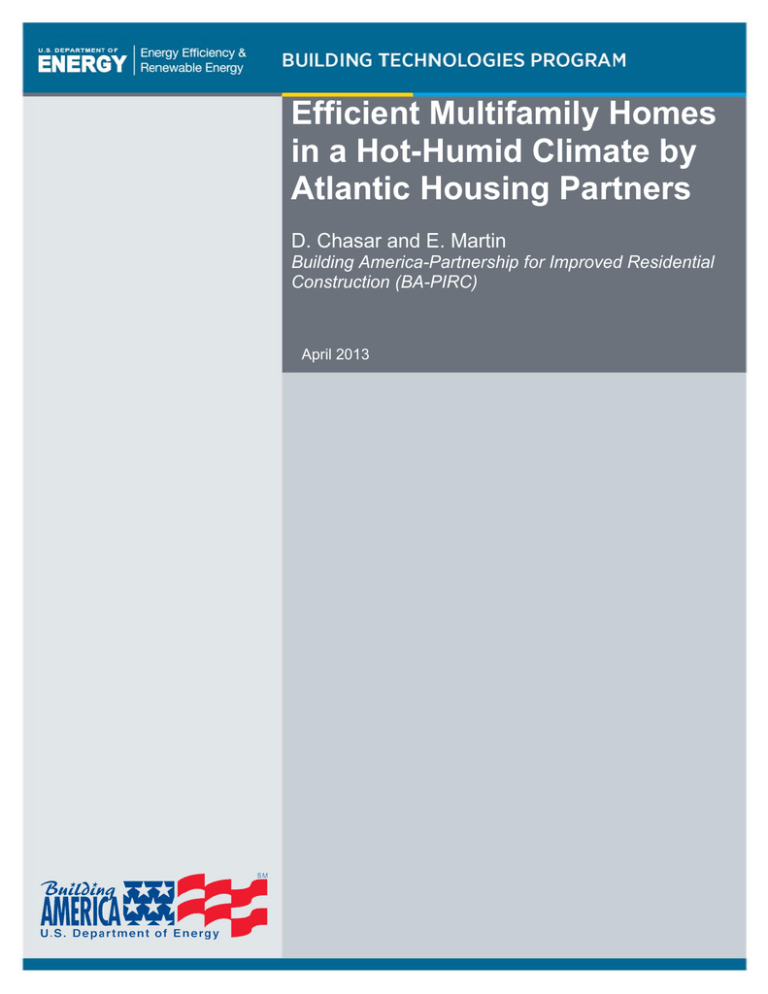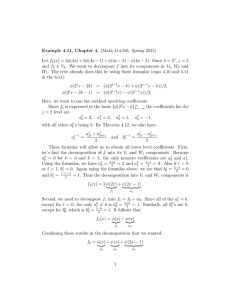Efficient Multifamily Homes in a Hot-Humid Climate by Atlantic Housing Partners
advertisement

Efficient Multifamily Homes in a Hot-Humid Climate by Atlantic Housing Partners D. Chasar and E. Martin Building America-Partnership for Improved Residential Construction (BA-PIRC) April 2013 NOTICE This report was prepared as an account of work sponsored by an agency of the United States government. Neither the United States government nor any agency thereof, nor any of their employees, subcontractors, or affiliated partners makes any warranty, express or implied, or assumes any legal liability or responsibility for the accuracy, completeness, or usefulness of any information, apparatus, product, or process disclosed, or represents that its use would not infringe privately owned rights. Reference herein to any specific commercial product, process, or service by trade name, trademark, manufacturer, or otherwise does not necessarily constitute or imply its endorsement, recommendation, or favoring by the United States government or any agency thereof. The views and opinions of authors expressed herein do not necessarily state or reflect those of the United States government or any agency thereof. Available electronically at http://www.osti.gov/bridge Available for a processing fee to U.S. Department of Energy and its contractors, in paper, from: U.S. Department of Energy Office of Scientific and Technical Information P.O. Box 62 Oak Ridge, TN 37831-0062 phone: 865.576.8401 fax: 865.576.5728 email: mailto:reports@adonis.osti.gov Available for sale to the public, in paper, from: U.S. Department of Commerce National Technical Information Service 5285 Port Royal Road Springfield, VA 22161 phone: 800.553.6847 fax: 703.605.6900 email: orders@ntis.fedworld.gov online ordering: http://www.ntis.gov/ordering.htm Printed on paper containing at least 50% wastepaper, including 20% postconsumer waste Efficient Multifamily Homes in a Hot Humid Climate by Atlantic Housing Partners Prepared for: The National Renewable Energy Laboratory On behalf of the U.S. Department of Energy’s Building America Program Office of Energy Efficiency and Renewable Energy 15013 Denver West Parkway Golden, CO 80401 NREL Contract No. DE-AC36-08GO28308 Prepared by: Dave Chasar and Eric Martin BA-PIRC / Florida Solar Energy Center Florida Solar Energy Center 1679 Clearlake Road Cocoa, Florida 32922 NREL Technical Monitor: Stacey Rothgeb Prepared under Subcontract No. KNDJ-0-40339-02 April 2013 iii [This page left blank] iv Contents List of Figures ............................................................................................................................................ vi List of Tables .............................................................................................................................................. vi Definitions .................................................................................................................................................. vii Executive Summary ................................................................................................................................. viii 1 Introduction ........................................................................................................................................... 1 2 Background ........................................................................................................................................... 1 3 Energy Efficiency Specifications ........................................................................................................ 3 3.1 Development of the High Performance Package .................................................................3 3.2 Enhancement of the High Performance Package .................................................................5 4 Heat Pump Water Heater Survey Results .......................................................................................... 6 5 BEopt Analysis ..................................................................................................................................... 7 6 Apartment Rating Results ................................................................................................................... 8 7 Conclusions ........................................................................................................................................ 10 References ................................................................................................................................................. 11 Appendix A – Duct Sealing Procedures ................................................................................................. 12 Appendix B – Heat Pump Water Heater Survey Results ....................................................................... 13 v List of Figures Figure 1. Cambridge Cove II Development, completed in 2008. ............................................................ 2 Figure 2. Plan detail for outdoor air ventilation and future dehumidifier (Source: Slocum Platts Architects, reprinted with permission). .............................................................................................. 3 Figure 3. Estimated savings from improvements to a three bedroom apartment (assumes $0.13/kilowatt-hour (kWh) and $2.15/therm). ..................................................................................... 4 Figure 4. Plan view of the two most common types of AHP HPWH installations—breezeway installation on left (back to back units) and kitchen installation on right (Source: Slocum Platts Architects, reprinted with permission). .............................................................................................. 7 Figure 5. BEopt analysis results for second floor, 937 ft2 2-bedroom apartment unit. ....................... 8 Figure 6. Distribution of HERS Index for 934 AHP-rated units. .............................................................. 9 Figure 7. Duct sealing procedures (Source: Slocum Platts Architects, reprinted with permission 12 Unless otherwise noted, all figures were created by BA-PIRC. List of Tables Table 1. Construction and Equipment Details. ........................................................................................ 5 Table 2. BEopt E+ 1.4 Analysis of Typical Two Bedroom (997 ft2) Apartment Unit. ............................ 8 Unless otherwise noted, all figures were created by BA-PIRC. vi Definitions A/C Air conditioning/air conditioner AHP Atlantic Housing Partners BA-PIRC Building America Partnership for Improved Residential Construction CFM Cubic feet per minute EF Energy Factor FSEC Florida Solar Energy Center HERS Home Energy Rating System HPWH Heat Pump Water Heaters IAQ Indoor Air Quality HVAC Heating, ventilation, and air conditioning kW Kilowatt kWh Kilowatt-hour MBtu/yr Million British Thermal Units Per Year PV Photovoltaic R A measure of resistance to the flow of heat through a given thickness of a material (as insulation) with higher numbers indicating better insulating properties SEER Seasonal energy efficiency ratio SHGC Solar Heat Gain Coefficient U A measure of the flow of heat through an insulating or building material Utility Allowance Cost of utilities in federally assisted public housing established either by the local Public Housing Agency or by an engineering-based methodology vii Executive Summary With assistance from the Florida Solar Energy Center (FSEC) and its Building America Partnership for Improved Residential Construction (BA-PIRC), Atlantic Housing Partners (AHP) has implemented a high performance, systems-engineered package of measures in the new construction multifamily housing sector in the hot-humid climate zone. This report demonstrates how the initiative achieves Building America (BA) goals of 30%-50% energy savings. In addition, the report discusses the role of utility allowance calculations, used as part of the lowincome housing tax credit process, to value those energy savings. Results of energy modeling are presented to demonstrate that the specification package achieves 40% energy savings in typical application. Results from Home Energy Rating System (HERS) ratings from more than 1,000 apartment units are included to show consistency of application on a large scale. A primary consistency has been communication of design intent via detailed schematics and step-by-step instructions in construction documents. In addition, this report describes some successes and challenges with the use of heat pump water heaters (HPWH) on a widespread basis, a key measure toward achieving the documented efficiency. Overall, the information provided in this report is most useful to multifamily developers looking to duplicate success through incorporating energy efficient strategies, and methods to value that efficiency in a rental, rather than homeownership, setting. viii 1 Introduction Atlantic Housing Partners (AHP) is an affordable multifamily developer that has participated in research with the Florida Solar Energy Center (FSEC) at various levels since 2003. Currently, AHP has a substantial portfolio of affordable multifamily rentals that includes more than 24,000 units at 112 communities, primarily in Florida. As a U.S. Department of Energy (DOE) Building America (BA) research team, the Building America Partnership for Improved Residential Construction (BA-PIRC) has worked with AHP to steadily improve the efficiency and durability of these units’ construction in recent years. The goal of the BA program is to conduct research to develop market-ready energy solutions that improve the efficiency of new and existing homes by 30%-50% (compared to 2009 energy codes for new homes and pre-retrofit energy use for existing homes). Through targeted research, industry partnerships, and collaboration with related DOE residential initiatives, BA works to make cost-effective energy efficient homes a reality for all Americans. Along with energy savings, the program also focuses on solutions that lead to: • • • • Improved occupant health through effective indoor air quality Higher comfort levels in all rooms throughout the home Durable and moisture-resistant building designs Increased builder profitability. This report demonstrates achievement of these goals by documenting efficient multifamily housing that is built cost effectively and on a large scale. While BA has conducted similar efforts for attached housing in hot-dry (Dakin, 2012), cold (Aldrich, 2012), and marine (Gordon, 2012) climates, little work has been done to demonstrate achievement of BA goals in this housing sector in hot-humid climates. The report presents results of energy modeling that document typical performance of the specification package, along with Home Energy Rating System (HERS) ratings conducted on a large scale to show consistency of application. A key aspect of this research includes how efficiency packages can be optimized in the context of multifamily rental housing built with low-income housing tax credits. This funding mechanism requires that the total cost of rent plus utilities be capped according to affordability criteria for the region. 2 Background In 2003, FSEC assisted AHP with their first ENERGY STAR community, which consisted of 208 units in Gainesville, Florida. In addition, since 2008, FSEC has assisted AHP with the installation of over 500 kilowatts (kW) of photovoltaic (PV) energy systems in ten communities. The systems are used to offset common area energy use (clubhouse, pool, etc.) at select AHP communities in Florida (see Figure 1 example). 1 Figure 1. Cambridge Cove II Development, completed in 2008. Much of the early assistance provided to AHP targeted non-energy-related concerns, such as high wintertime indoor humidity and building envelope moisture problems. Measurements at several Florida developments showed a pattern of high indoor humidity levels in some apartments during winter months. The worst problems were found in first floor, north-facing units where low solar loads resulted in the tendency for air conditioning (A/C) capacity to be oversized. Assistance with A/C sizing procedures led to an improved match with cooling loads, which varied widely by apartment size, orientation, and location in the two- to three-story designs. Initial results yielded a size reduction of roughly 1-ton per apartment at one development. Additional modifications to address the problem included addition of an outside air duct providing 30 to 75 CFM (depending on apartment size) of supply ventilation to the return plenum during space conditioning operation. The team also added utilities and space clearance to allow for addition of a supplemental dehumidifier (if needed). A schematic of the air handler closet incorporating these features is shown in Figure 2. FSEC and its partners have successfully used this mechanical ventilation strategy, involving the intermittent introduction of limited quantities of conditioned outside air, on thousands of homes to accomplish a number of objectives (Chandra, et al 2008). This feature was subsequently added as a standard feature in AHP construction, and no moisture-related complaints have been reported since these modifications were implemented. 2 Figure 2. Plan detail for outdoor air ventilation and future dehumidifier (Source: Slocum Platts Architects, reprinted with permission). 3 Energy Efficiency Specifications 3.1 Development of the High Performance Package One of the first steps to enhancing the performance of AHP multifamily units was revision of a duct sealing procedure and incorporation into the mechanical plan section of construction documents. This included step-by-step procedures (see Appendix A) on the use of foil tape, mastic, glass fab mesh, duct board components, and flex duct take-offs, as well as guidance on sealing interfaces between ducts and drywall. As shown in Figure 2, proper air sealing practices during construction are particularly important where ducts are located between living spaces with limited access on the first and second floors. Ducts in third floor units are located in the vented attic. Duct testing results from over 900 units showed average leakage to out (Qn) of 0.04 or 4 CFM per 100 ft2 of floor area. Limited random duct testing performed on AHP construction prior to these advancements revealed that many units were already meeting high performance leakage targets of 3 to 6 CFM per 100 ft2, but occasional outliers had much higher leakage rates. New 3 procedures implemented on current construction have all but eliminated the high leakage outliers. The team performed analysis to show the relative energy savings of various potential enhancements in a typical AHP dwelling unit. At the time of construction, AHP developments were built with a roughly even mix of all-electric and gas-electric utilities. Figure 3 shows the resulting savings from various measures in a typical top-floor, three-bedroom apartment at a development with both electric and gas utilities. Measures added to AHP’s standard construction included radiant barrier, programmable thermostats, and ENERGY STAR appliances. The more costly improvements, such as improved water heating and enhanced A/C efficiency, were not implemented initially. Estimated Annual Savings Individual $250 $216 $200 $99 G 83 ol ar S EF . IC S H W /C 17 A /C A ER 15 . Fl uo r SE ER . % Fl uo r (2 ) $125 $66 $57 80 W in d W in d ow s (1 ) ri g t ta rR ef Tst a ES Pr o gr am .B ar rie r $- R ad $28 $3 % $12 50 $28 ow s $50 $44 SE $100 $99 as $150 Figure 3. Estimated savings from improvements to a three bedroom apartment (assumes $0.13/kilowatt-hour (kWh) and $2.15/therm). For some of AHP’s developments, incentives from the natural gas utility encouraged the use of multiple gas appliances including oven/range, dryer, hot water and space heating. FSEC and AHP began investigating a change from standard tank gas water heaters with an energy factor (EF) of 0.62 to tankless gas with an EF of 0.82. AHP had already made hydronic space heating sourced from the water heater a common practice in developments where gas was present. A side-by-side field comparison of tank and tankless gas water heaters conducted by FSEC in 2009 showed a 20% measured savings for the tankless unit. This upgrade was never implemented on a large scale, for even with the utility incentives, the cost was considered prohibitive by the developer. 4 3.2 Enhancement of the High Performance Package AHP primarily builds projects with funding through low-income housing tax credits, which require limiting the total cost of rent plus utilities to specified amounts according to affordability criteria for the project’s region. The allowance for each apartment’s utility cost is typically estimated by local housing authorities, or a utility company, based on comparable properties. In 2010, a simulation-based alternative was introduced by the funding agency enabling customized energy cost estimates that account for energy efficiency measures that may not be present in otherwise comparable properties. Reduced annual energy use projected by the simulation alternative provides the basis for lower monthly utility allowances. It also provides a corresponding increase in income for the developer, given that total cost paid by the tenant remains fixed. The new incentive offered by simulation-based utility allowances caused AHP to re-examine the cost effectiveness of further efficiency upgrades. The wider availability of heat pump water heaters (HPWH) offered by AHP’s primary appliance supplier and analysis by FSEC showing greater savings with an all-electric design resulted in the developer suspending construction of properties with gas utilities. The enhanced, all-electric package also included a 15 SEER heat pump and progressively greater amounts of fluorescent lighting. Table 1 shows the details of this package including average performance testing results and HERS Indices from 1,086 of their most recently constructed units. Table 1. Construction and Equipment Details. Component Construction styles Construction type Floor type /area (ft2) Attic /roof type Window type Glass/floor area Insulation attic/wall/floor Exterior wall cladding Space conditioning Thermostat Ventilation Water heater ENERGY STAR appliances Fluorescent lighting Infiltration (ACH50) Duct leakage Qn HERS Index Component Type and/or Value 1-story and 2-story townhomes and single level apartments in 3-story buildings Wood-frame Slab-on-grade / 720 (1BR) to 1660 (4BR) Vented / medium colored shingle U-value 0.35, SHGC* 0.30 6 to 10% R-30 / R-15 / R-0 Medium colored cement board SEER 15 heat pump Programmable 30 to 75 CFM** (runtime at return plenum) 50-gal HPWH (in all but one project)*** Refrigerator, dishwasher 84% average (range: 10% to 100%) 6.0 average (range: 2.3 to 13.2) 0.039 average (range: 0.008 to 0.154) 59.2 average (range 51 to 77) * Solar heat gain coefficient * *Cubic feet per minute *** Standard electric tank water heaters were used in one project totaling 90 units 5 4 Heat Pump Water Heater Survey Results AHP began installing HPWHs in most new-construction units in 2010. To date, there have been 996 HPWHs installed at nine Atlantic communities, with several more developments planned for 2013. An informal survey was conducted with managers at seven communities to determine the success of HPWHs over standard electric units. Survey results are shown in Appendix B. The number one complaint from tenants was the noise level generated by the evaporator fan. This problem was sufficient in some cases such that the heat pump feature was overridden by community management by placing the unit in standard heating mode. Standard mode is the least efficient setting where heating is provided via the electric resistance element as in a standard electric water heater. These cases were found primarily to exist in apartments where the HPWH was located in an interior closet where sound transmission is largely unimpeded. Many Atlantic apartment units use an exterior closet accessible from a common breezeway for easy maintenance, and this layout generated far fewer complaints. A plan view of these two installation scenarios is illustrated in Figure 4. The overall experience with HPWH has been positive, and AHP continues to install them on a large scale except where floor plans place the unit inside the apartment, especially in proximity to bedroom areas. Standard electric water heaters are used in these cases, which exist on a limited basis. 6 Heat Pump Water Heater Locations Figure 4. Plan view of the two most common types of AHP HPWH installations—breezeway installation on left (back to back units) and kitchen installation on right (Source: Slocum Platts Architects, reprinted with permission). 5 BEopt Analysis There are a limited number of apartment styles produced by AHP, and the majority of them are single-level units grouped in three-story buildings. Variations in home energy rating results were noted between floor levels, with the best scores occurring at the bottom level and the worst scores at the top level. This variation was also noted during analysis with BEopt E+ 1.4 with the lower and middle floor showing greater savings than the top floor. The primary drivers of this phenomenon are thought to be the additional ceiling cooling load and higher duct leakage to the 7 outside present in third floor units, which are not present on lower building levels. Ground coupling of the slab seems to provide benefit to first floor units compared to second floor units. A typical two-bedroom unit was chosen for analysis, as this apartment style occurs frequently in AHP developments. The results in Table 2 and Figure 5 reflect savings over the adjusted BA Benchmark (Hendron, 2010), which results from the specifications in Table 1 (Section 3.1). Table 2. BEopt E+ 1.4 Analysis of Typical Two Bedroom (997 ft2) Apartment Unit. Unit type BA Benchmark** Design Savings Source Energy (MBtu/yr*) 1 Floor 2nd Floor 3rd Floor 161.1 156.5 156.5 89.6 92.9 95.5 44% 41% 39% st Notes: *Million British thermal units per year **adjusted Building America Benchmark (area weighted) Figure 5. BEopt analysis results for second floor, 937 ft2 2-bedroom apartment unit. 6 Apartment Rating Results AHP began conducting a HERS rating on each apartment in all new developments to comply with requirements defined in the simulation-based allowance calculation method. Results of these ratings were compiled for 1,086 Atlantic units from nine central Florida developments constructed between 2010 and 2012. Building construction, equipment, and testing details are shown in Table 1 (Section 3.1). The values listed represent a typical new Atlantic dwelling unit where construction and equipment specifications are largely standardized within the company. 8 Two equipment items (fluorescent lighting and water heating) were found to vary between construction projects. HPWHs are being specified on all new Atlantic projects, but one 90-unit project used standard electric tank water heaters instead. Fluorescent lighting was used only sparingly in the past (lighting roughly 10% of floor area), but Atlantic has experimented with higher levels on new projects and is now specifying 80%-100% fluorescent lighting as standard. There was a natural variation in duct and envelope tightness; however, on average, these measures were found to be adequate for high performance construction in central Florida. Results compiled from 1,086 rated units yielded an average HERS Index of 59.2 and ranged from a low of 51 to a high of 77. Figure 6 illustrates the HERS Index variation between 934 fully rated units. One development of 152 units was removed from this chart, as these units underwent “Class 2” Florida ratings. A Class 2 Florida rating consists of an on-site audit to verify construction features and equipment efficiencies. This “audit-only” type of rating requires no duct or envelope performance testing. Instead, it assumes relatively large default leakage values, which resulted in a HERS range of 63 to 77. Performing full energy ratings on these units (including duct and envelope testing) would likely have resulted in HERS values similar to the remaining apartment sample. Removing the Class 2 ratings from the sample yields an average HERS of 57.6 (range 51 to 68), which should represent the average rating for the high performance set of specifications implemented by AHP. Atlantic Housing Partners HERS Ratings 140 Number of Dwellings 120 Total Ratings = 934 100 80 60 40 20 0 51 52 53 54 55 56 57 58 59 60 61 62 63 64 HERS Index Figure 6. Distribution of HERS Index for 934 AHP-rated units. 9 65 66 67 68 7 Conclusions AHP has made progressive strides to improve the efficiency and durability of their multifamily developments. Recent improvements, such as HPWHs and 15 SEER heat pumps, enable Atlantic’s new construction units to achieve 40% energy savings above the BA Benchmark, correlating to HERS Indices in the 50s and 60s. The commercial viability of the high performance specification package is demonstrated through its incorporation across AHP’s entire portfolio, in over 1000 units. This viability is made possible, in part, due to a simulation-based method for calculating utility allowances used by developments funded by low-income housing tax credits. The simulation-based method assigns value to the energy savings, which are returned to the developer through increased revenue. Tenants benefit from enhanced humidity control, comfort and indoor air quality resulting from a systems-engineered package which includes right-sized HVAC systems, mechanical ventilation, and performance testing of duct and envelope leakage to manage uncontrolled air flow. One component of the package, the HPWH, did prove problematic in certain installations. A survey conducted with managers at seven communities yielded positive feedback overall regarding the success of installing HPWHs over standard electric units; however, some noise complaints were received. Steps to resolve those noise complaints have been taken, along with steps to prevent them in the future. Through the installation of nearly 1,000 HPWHs at nine communities, AHP learned that occupants accept the units, and maintenance is manageable. Hence, AHP plans to continue installing HPWHs on a large scale. 10 References Aldrich, R. (2012). Wisdom Way Solar Village: Design, Construction, and Analysis of a LowEnergy Community. Golden, CO: National Renewable Energy Laboratory. Dakin, B.; Backman, C.; Hoeschele, M.; and German, A. (2012). West Village Community: Quality Management Processes and Preliminary Heat Pump Water Heater Performance. Golden, CO: National Renewable Energy Laboratory. Chandra, S.; Parker, D.; Sherwin, J.; Colon, C.; Fonorow, K.; Stroer, D.; Martin, E.; McIlvaine, J.; Chasar, D.; Moyer, N.; Thomas-Rees, S.; Hoak, D.; Beal, D.; and Gil, C. (2008). An Overview of Building America Industrialized Housing Partnership (BAIHP) Activities in Hot-Humid Climates, Sixteenth Symposium on Improving Building Systems in Hot and Humid Climates, December 15-17, 2008, in Dallas, TX. Gordon, A.; Lubliner, M.; Howard, L.; and Kunkle, R. (2012). Evaluation of Savings in Energy Efficient Public Housing in the Pacific Northwest. Golden, CO: National Renewable Energy Laboratory. Hendron, R; and Engebrecht, C. (2010). Building America House Simulation Protocols. Golden, CO: National Renewable Energy Laboratory. 11 Appendix A – Duct Sealing Procedures Figure 7. Duct sealing procedures (Source: Slocum Platts Architects, reprinted with permission 12 Appendix B – Heat Pump Water Heater Survey Results No. 1 2 3 4 5 6 Question HH HB CC PP SR BV FB Have there been any tenant-related complaints? yes yes yes yes yes yes yes yes, 2 units no fan blower several asked to turn off a insufficient supply or lack of hot water? some units with small families no no yes, 1 unit b noticeable noise from unit? fan blower fan blower fan blower fan blower c noticeable cold air near unit? some have used space heating yes yes yes yes no no Have you noticed any blocking of transfer grills connected to the water heater location? no no no no no no no Have there been any issues with the air filter or condensate drainage and is maintenance scheduled to check these items? No issues to date. Maintenance scheduled every quarter. Some condensate not connected to drain line. Maintenance scheduled every quarter. Some condensate not connected to drain line. Maintenance scheduled every quarter. Some condensate blockage. Checked during Quarterly Maintenance. No issues to date. Maintenance scheduled every quarter. Some scum buildup in drain pans. Maintenance scheduled every quarter. Some condensate blockage. Checked during Quarterly Maintenance. no no no no no no yes no Has the temperature been altered from the no factory preset of 120degF? Have units been altered from default mode? no · eHeat (most efficient) · standard (least efficient, same as traditional) · hybrid (default mode) · high demand (less efficient than hybrid) Have any of the following features been used? no high demand (to increase speed of hot water output) vacation (to save additional energy when vacant) "stop cold air" (puts unit in traditional heating mode) complaints from 8-9 residents about 25 complaints yes, due to noise no no 13 no no some raised to no 125F yes yes yes, due to noise yes, due to noise yes yes no no yes, due to noise no yes no DOE/GO-102013-3887 ▪ April 2013 Printed with a renewable-source ink on paper containing at least 50% wastepaper, including 10% post-consumer waste.





